Or, Sandy Ridge, part seven
I have been writing about the neighborhood of Sandy Ridge for several weeks now, but have neglected probably the most important family to live there—the Vandolahs. It is time to remedy that omission.
The reason for claiming that the Vandolahs were so important to this area is well expressed by Egbert T. Bush in his article, “Sandy Ridge Long a Farm Community.” He wrote:
On the south side of the road, opposite to these two properties [the lots on the north side of Sandy Ridge Road, next to the church], lies the old Van Dolah farm, famous for having been in possession of one family for over 200 years. Hendrick Van Dolah, a Hollander, took possession in 1725, renting the farm of Eden Marcellison. In 1738 he took title to the property; and from that time to this, it has lain in the Van Dolah name, all of the owners having been descendants of old Hendrick the Hollander.
The writer has been unable to find another farm in Hunterdon County having a record of family ownership equal to this. If someone knows how to break this record, our antiquaries will welcome the breaking.
The record of over 200 years ended with the death of Cyrus Vandolah in 1931. According to Mr. Bush, Cyrus was “the last to bear the name of Van Dolah.” More specifically, he was the last in the neighborhood of Sandy Ridge (see the Vandolah Family Tree).
This is a tale of two Henry’s, two Garret’s, and two Cyrus’s. Let’s begin at the beginning.
Hendrick Vandolah and His Family
To write about the Vandolah’s one must go back to the earliest years of settlement in the Sandy Ridge neighborhood.
The Dutch immigrant, Hendrick Vandolah, appeared in the Sandy Ridge neighborhood as early as 1725, which was twenty-five years before Valentine Ent purchased his 410 acres out of the Dimsdale tract. Mr. Bush stated that Vandolah rented the farm of Eden Marselison that year, and he probably based that statement on an old record he found in the Vandolah papers after the death of Cyrus Vandolah. I have not seen this document and cannot say for sure if it exists.
But the date is probably correct because Hendrick’s first child, son Garret, was born in 1726 in Amwell Township. Hendrick himself was probably born about 1700. Sadly there is no surviving Bible record to inform us of the date of his birth, or the date of his marriage to Sarah Garrison.
An unanswered question is whether Hendrick married in Holland, or after arriving in Amwell Township. It is also not certain that his wife’s maiden name was Garrison; Garrison may have been the name of a previous husband. However, she may have been a sister of John Garrison, who was living in Amwell Township at the same time as Vandolah.
Hendrick and Sarah were not the very first settlers in the area, but probably a close second.
Although the first landowners, Robert Dimsdale and Benjamin Field, who purchased their huge tracts of land in 1701, were definitely absentee owners, the people they sold to seem to have resided in Hunterdon. Dimsdale’s property was bought by John Lambert, although his home was in Kingwood Township. Lambert did not sell the northern half, consisting of most of Sandy Ridge, until 1750, to Valentine Ent.
Benjamin Field’s property is another matter. It was sold to one John Way, who in 1722 sold it to Eden Marselison and John Van Vorst, and there is some evidence that both men and their families did take up residence. But that was very close to the time when Hendrick and Sarah Vandolah arrived.
Another early family was that of Johannes Johnson and Maria Okerson. Johnson also purchased part of Marselison’s plantation, and his daughter Alida/Eliada Johnson married Samuel Barber about 1720. However, I cannot be specific about where Johnson was living. Samuel and Alida Barber settled well to the south of Sandy Ridge on Lambertville-Headquarters Road.
A few years after that, Abraham Hagaman and Abraham Butterfoss arrived, followed by Valentine Ent & wife Susannah Moore, William & Catrien Taylor, Abraham & Charity Deremer, and a little later on, Samuel Hunt & wife Mary Reeder, and Robert Sharp, who married Rachel Ent. Those were the first families known to reside in or near Sandy Ridge.
Vandolah’s Land Purchase
As mentioned above, Eden Marselison and John VanVorst purchased a large tract of land from John Way of Newtown, Long Island in 1722, which was previously surveyed to Benjamin Field. It was described then as 700 acres for which Marselison and Van Forst paid £222. This land was not part of the Dimsdale tract. It lay adjacent on the northeast side, as you can see from the map drawn by D. Stanton Hammond.1
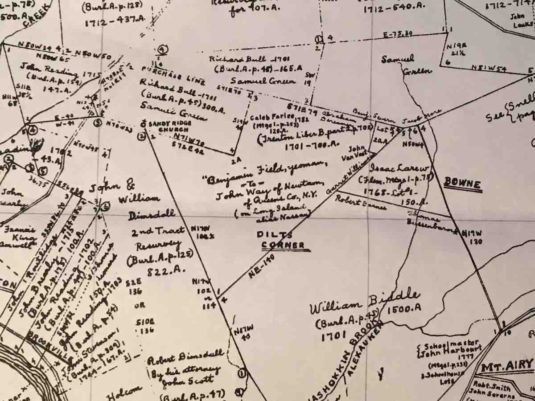
Field’s purchase and survey were among the earliest land transactions in Amwell Township. The property was part of the 30,000 acres surveyed for and conveyed to Adlord Boude, agent for Daniel Coxe, by eleven Indian Sachems in 1688, in exchange for various tools and guns.2 All of Sandy Ridge was part of this huge tract of land that only gradually got subdivided.
The Field tract of 700 acres extended from the east side of the Sandy Ridge-Mt. Airy Road to Bowne Station Road. It was purchased by John Way of Newtown, Queens County, NY on March 13, 1701 from Benjamin Field of Chesterfield, Burlington County. Way paid £105.3 At that time, the tract bordered land of Richard Bull and William Biddle.4
John Way was still living in Queens in 1722 when he sold the 700 acres to Marselison and VanVorst. The property was located “above the Indian town of Jathalamensey,” which once existed not far south of Ringoes, along Route 31.5
In 1737, John Van Forst mortgaged a tract of 185 acres bordering Samuel Green, William Biddle, and Eden Maselesous [sic], described as “the place whereon the said John Vanforst [sic] and his improvements are now upon.”6 This property was on the east-northeast side of Buchanan Road, with the Vandolah tract on the west-southwest side of the road. This is one of the few records we have of VanVorst’s presence in Amwell. (His name was also written as Van Forst or Vanforst.) In 1747, he sold his property to Abraham Deremer.7
It appears that Henry Vandolah had been renting his land for over ten years before decided to purchase it. For evidence, we have two documents. One is a receipt dated May 6, 1738 acknowledging Vandolah’s debt to Marselison of 20 pounds. Egbert T. Bush found this among the papers of the Vandolah family after the death of Cyrus Vandolah in 1931. It read:
“Know all men by these presents that I, Hendrick Vandolah of the township of Amwell, County of Hunterdon and the Western Division of the Province of New Jersey Yeoman do acknowledge myself to stand firmly bound unto Eden Marcelison of Bound Brook in the County of Middlesex & Eastern Division of the Province of New Jersey Yeoman in the just and full sum of twenty pounds of Lawful money of the province to be paid to the said Edon Marcelison or” &c. “Sealed with my seal and dated this sixth day of May Anno Dom 1738.”
Mr. Bush also found the original deed from Marselison to Vandolah,
“ . . . a large and pretentious document, is also framed and protected by glass. This bears date of May 1, 1738, five days earlier than date of the foregoing bond, and is the only deed found for the property. As far as is now known, title to subsequent Van Dolah’s has come by devise or descent.”8
I have not seen this deed, but the chapter on Delaware Township in James P. Snell’s History of Hunterdon County states that the tract was 220 acres. The deed was not acknowledged until May 10, 1756.9
Henry Vandolah had also purchased land from Benjamin Howell located on the Alexauken Creek. He sold this to Richard Hainds in 1738.10
Hendrick Vandolah’s Family and House
Henry and Sarah Vandolah had five children, the eldest, Garret, being born in 1726, followed by Anna c.1728, John c.1730, Charity c.1735 and Peter, c.1740.
It is surprising to me that the daughters of Hendrick and Sarah Vandolah married men whose names are not familiar to the Amwell neighborhood: Anna to a Wilgus, Charity to a Hausman.
Son John apparently did not marry and died in his late 20s. Son Peter lived a long life, but spent it in Ohio with a wife named Hester. It is only son Garret (1726-1807) who remained to carry on the Vandolah name in Amwell Township (surprisingly, his wife’s maiden name is not known).
Henry and Sarah Vandolah’s home was located on the southeast corner of the intersection of Sandy Ridge Road and Sandy Ridge-Mount Airy Road. Here is a wonderful photograph of the Vandolah farmhouse, before it was tidied up. It’s architecture is very distinctive, as a one and a half story stuccoed-stone house with two front doors.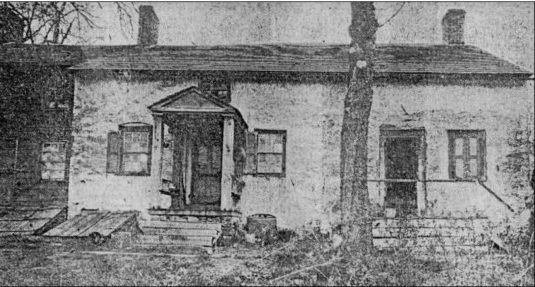 Photograph of the Vandolah house in the 1920s,
Photograph of the Vandolah house in the 1920s,
provided to me by Chris Hankins, original source not known.
With a family of seven, Vandolah certainly built some sort of house, but whether it was the one shown above cannot be said. It may have been built by his son Garret, who came of age not long after his father’s death. The house is included in the County Cultural & Heritage Historic Sites Survey, as well as the Township Survey, which is more detailed. It estimates the age of the house as 18th century, but does not specify early or late. Unfortunately, its interesting characteristics got somewhat obscured by its Colonial Revival “restoration” in the 20th century, as you can see:
Henry Vandolah’s Death
We know the daughters’ married names from their brother John’s last will and testament in 1758. We do not learn them from Hendrick’s will, as he died suddenly in 1743. He probably died from an accident, or else a swift disease. He was only in his early forties when he died, leaving his widow Sarah and five children. It was certainly unexpected, because he never wrote a will, or at least, one was never recorded.
His widow Sarah is thought to have remarried one Johannes Johnson. As mentioned above, there was a man of that name owning property in the neighborhood. In 1732 he bordered a tract of 130 acres that had been sold by Vandolah’s neighbor John Van Vorst. The deed stated that the Johnson land had been purchased from Eden Marselison, who had also sold land to Vandolah. This Johnson property later came to be owned by Johnson’s sons-in-law Samuel Barber and Caleb Farley, and also by Abraham Deremer.11
Johannes Johnson wrote his will in 1756 naming his wife Maria. If he had previously married Sarah Vandolah, then she must have died before then. On the other hand, Johannis’ son Johannis Jr. was much closer in age to Sarah than his father was, having been born around 1695. But Johannis Jr. died in 1756, the same year his father wrote his will, and his estate papers name the widow Rachel, not Sarah. We are left with the possibility that Sarah married Johannis around 1744 and died not long afterward, whereupon Johannis married Rachel.
What we do know of Sarah as a widow is that on December 5, 1743, she leased the Vandolah farmland to Andrew Orison under the name of Sarah Vandolah. And yet, on April 18, 1744, she signed a receipt to Capt. Derrick Hoagland as “Sarah Johnson, widow of Henry Vandolah.”12
Garret Vandolah
The Vandolah farm stayed in the family. As E. T. Bush wrote: “As far as is now known, title to subsequent Van Dolah’s has come by devise or descent.” This meant that the farm was passed on to the eldest son, who was Garret Vandolah, without any deed being recorded.
Garret Vandolah, the eldest son of Hendrick and Sarah, was born about 1726, which was shortly after his parents arrived in Amwell Township. About 30 years later he married his wife Catharine, and they had three children who made it to adulthood: Sarah c.1759, Henry 1766 and Aremina 1762. Apparently there were others who all died of smallpox.
Daughter Sarah Vandolah married William Wilson (c.1755 – after 1799). Aremina Vandolah married Isaac Francis Swallow (1763-1841) and left for Ohio. Henry Vandolah (1766-1815) carried on the family name at Sandy Ridge. He married Catherine Taylor and had ten children, and it is this family that firmly established the Vandolah name in Amwell Township.
Garret Vandolah was present as the property owner by 1750 when Valentine Ent purchased his 410 acres from John Lambert (As described in Sandy Ridge, part four). There are other records that also confirm Garret Vandolah’s active possession of the property.
One of the most important surviving documents for the history of the Vandolah farm is a deed dated September 23, 1793, in which Garret’s brother Peter Vandolah, then a resident of Washington in Fayette County, Pennsyvlania, released to his brother Garret his rights in his father Henry’s Amwell farm of 171.75 acres, “now in the possession of Garret Vandolah.” It bordered John Willson, Abraham Hagaman, Andrew Larison and Daniel Butterfoss.13
Prior to this date, Garret Vandolah had been paying taxes on the 170 acres, so this quit claim was just a formality.
Garret’s wife Catharine Vandolah died on March 10, 1800, age 77. She was buried in the Barber Cemetery, which suggests she might have been a member of that family. On August 10, 1807, her husband Garret died, age 81. He was buried beside her.
Five years earlier, on March 11, 1802, Garret Vandolah wrote his will, in which he made several provisions for his grandchildren, and left his plantation of 170 acres to his son Henry. (Once again, the property passed “by devise or descent.”)
He left his fowling piece to grandson Garret, his large Bible to granddaughter Mary, and a colt each to grandsons Garret and Daniel Willson. He left £119-10-0 to daughter Aremina Swallow and to daughter Sarah Willson $60, one cow and 11 acres of land “whereon she now lives” and another lot of four acres (in trust with son Henry Vandolah). Odd that one granddaughter would get a bequest in pounds & ounces, and the other in dollars.
To his son Henry, he left “the plantation whereon I now live of 170 acres bounded by lands of Daniel Butterfoss, Samuel Hunt, John Willson and John Hagerman.” (Compared with John Willson, Abraham Hagaman, Andrew Laraison, and Daniel Butterfoss in Peter Vandolah’s quit claim of 1793.)
He also left the residue of his personal estate to Henry with the provision that he pay his two sisters their legacies, which he would have to do anyway since Henry was named executor of the estate, along with Garret’s grandson Garret Wilson.
Henry and Catharine Taylor Vandolah
When Garret Vandolah died in 1807, his son Henry, who was born in 1766, was already 41 years old. He had no doubt been active in the maintenance of the Vandolah farm during his father’s later years. In 1790, Garret and Henry Vandolah were taxed jointly on a tract of 100 acres. Around that time, Henry began purchasing small lots adjacent to his farm, mostly all woodlots.
As a child Henry Vandolah had been apprenticed to Jacob Holcombe, wheelwright of Amwell for almost three years, a skill that was no doubt useful while managing a large farm. He used his general carpentry skills not just for his own farm and household, but also for bartering. In 1795 he managed to pay for a piece of property with a wagon body he had built. (See “They Cut a Wagon in Half.”)
Henry Vandolah married Catherine Taylor about 1794. She was the daughter of William Taylor and Mary Swallow, who lived near Mount Airy.
Catherine and Henry had 10 children. The daughters were Mary (1795-1890, married Amos P. Hunt); Catherine (1802-1874, never married), Amy (1809-1901, married Joseph Lair), Elizabeth (1811-1886, married George W. Sharp), Henrietta (c.1816-1903, married Oscar D. Runkle) and Sarah who died an infant in 1815. Except for Sarah, all lived to a ripe old age.
The sons were:
1) Garret Vandolah (b. July 25, 1797, d. Sep 30, 1877) who married Sarah Romine on March 10, 1831. They may have had one child, George. Sarah Romine Vandolah (b. Aug 7, 1807, d. Oct 11, 1862) was the daughter of Furman Romine and Ann Holcombe. Garret and Sarah were buried in the Barber Cemetery.
2) William Taylor Vandolah (b. 1799, d. 1875) married Maria Sergeant, and moved away to Rochester, NY.
3) John Vandolah (b. Jan 18, 1804, d. Jan 30, 1885) married Grace Opdycke (b. Sep 9, 1807, d. Aug 4, 1881) Both were buried in the Rosemont Cemetery. She was the daughter of Joshua Opdycke and Mary Wolverton. Sadly, she killed herself, at the age of 73, by throwing herself into the barn well on their property in Kingwood Township.
4) Cyrus Vandolah (b. May 30, 1806, d. May 5, 1891) married first Mary Elizabeth Lawshe (b. Jul 9, 1816, d. Mar 28, 1863). She was the daughter of Henry Lawshe and Mary Moore. They had seven children, the youngest of whom, Cyrus Jr., was the good friend of Egbert T. Bush, and advisor to Laura Groff.
After the death of Mary Elizabeth, Cyrus Vandolah married second Elizabeth Ann Hice (1808-1884), daughter of Jacob Hice and Ruth Moore of Sand Brook. The marriage probably took place about 1868, although I have not found a record of it. They had no children. Cyrus and his two wives were buried in the Lower Amwell Old Yard. The family were members of the German Baptist Church near Sand Brook and Headquarters, rather than the Sandy Ridge Baptist Church.
Catherine Taylor Vandolah lived to be 75. She was listed in the Delaware Twp. census of 1850, as age 72, living with her unmarried daughter Catherine Vandolah, who was 48. Too bad the census does not tell us exactly where these people were living. Prior to her death in 1854, Catherine was involved in several land transactions concerning multiple mortgages acquire by John Hunt and wife Esther Dilts for a 20-acre lot that Hunt had purchased in 1838 from the heirs of Henry Vandolah, dec’d.14
Garret Vandolah

Garret Vandolah (1797-1877) took over the Vandolah farm from his father in 1815 when he was only 18 years old. He was 34 when he married his wife Sarah Romine, who was 25 at the time. As mentioned above, she was the daughter of Furman Romine and Ann Holcombe, who lived between Sandy Ridge and Brookville, on a farm bordered by John Lambert and Robert Sharp. Furman Romine had inherited this property from his father, James Romine, who died in 1817.15
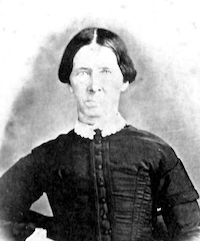
Photographs of Garret Vandolah and wife Sarah ‘Sallie’ Romine were shared with me by Linda Mahler, and added to the original article soon after it was first published on March 23, 2019.
1817 was when the Sandy Ridge Baptist Church was getting established under Rev. Charles Bartolette. Daniel Butterfoss and Garret Vandolah donated property for a new church lot. It surprises me that Vandolah did this well before he had gotten clear title to the old farm. In order to do so, he had to buy out his siblings. As an example, as late as April 7, 1828, he purchased from his brother William “his undivided share in land of Henry Vandolah dec’d being an undivided ninth part of two full equal third parts, after deducting the widow’s dower, and also his one half share being the same purchased by Garret & William Vandolah from Amos P. Hunt & wife Mary on 13 May 1822.”16 There were more deeds of this sort in the 1830s conveying rights in the farm to Garret Vandolah. This was fairly expensive. Garret had to pay William $430 for his share, and more for the rest, so perhaps that is why this was done over a period of time.
The 1851 Cornell map and the 1860 Philadelphia map show “G. Vandoler” at the Vandolah farm. But in 1873, when the Beers Atlas was published, no name appeared for that location. Was the farm abandoned then? No—Garret Vandolah did not die until 1877. It’s hard to understand why the farm was missed.
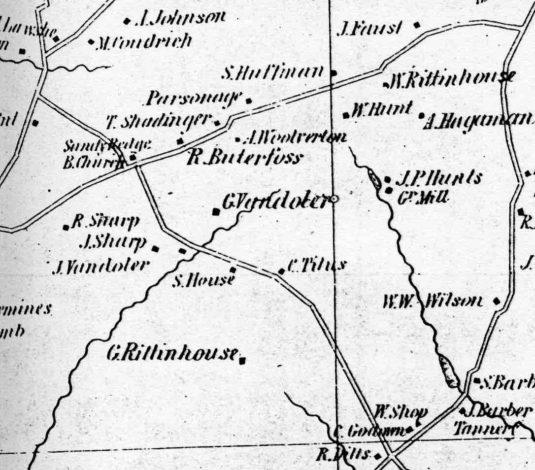 When Mr. Bush wrote that after his wife Hannah’s death, Cyrus Vandolah “spent much of his time alone on the old farm,” he meant the old Vandolah farm, not the one purchased by Cyrus’ father near Bowne Station. That is because the farm was specifically bequeathed to him by his uncle Garret Vandolah.
When Mr. Bush wrote that after his wife Hannah’s death, Cyrus Vandolah “spent much of his time alone on the old farm,” he meant the old Vandolah farm, not the one purchased by Cyrus’ father near Bowne Station. That is because the farm was specifically bequeathed to him by his uncle Garret Vandolah.
In his will, dated July 13, 1876, Garret Vandolah bequeathed to his nephew Cyrus Van Dolah, “all my farm in Delaware Twp. where I now reside containing 113 acres more or less, also my Smith, Home, Rifle Gun.”17 He left the residue of his possessions of whatever kind to be divided equally between his sibling or their children.
Garret Vandolah September 30, 1877 and was buried in the Barber Cemetery, rather than the Sandy Ridge Cemetery. This is probably because his wife and her family were buried there. But it still seems odd considering how close he lived to the church and cemetery.
Cyrus Vandolah, Sr.
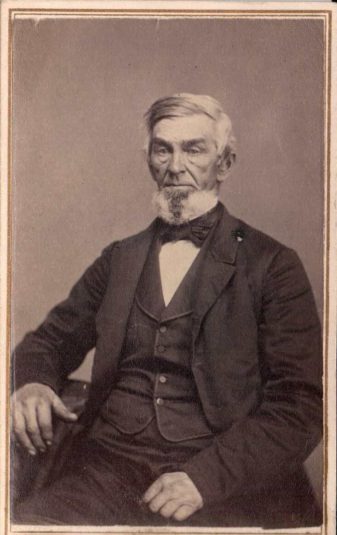
This severe-looking gentleman was Garret Vandolah’s brother, born May 30, 1806. He married Mary A. Lawshe in 1836, daughter of Henry Lawshe and Mary Moore. She was born July 9, 1816 and had seven children.
Of the seven children, only three were sons, one of whom, George S. Vandolah, died in 1862, age 19. The eldest son Henry Lawshe Vandolah (1840-1901) married Louisa Wilson in 1864. She was the daughter of Joseph L. Wilson and Hannah A. Holcombe. She died only five years later, so Henry married second Rachel B. Rittenhouse, daughter of Wilson B. Rittenhouse and Ury Ann Ent. From 1876 through 1901, Henry Vandolah bought several properties, none of which were attached to the old Vandolah farm.
Henry’s sisters, Julia Ann and Mary Catherine, also married Wilsons. Julia Ann’s husband was George Prall Wilson (1838-1920), son of George Ege Wilson and Caroline McDonald Prall. Mary Catherine married Lemuel Howell Wilson (1838-1901), son of John S. Wilson and Mary Cox Howell. Turns out, John S. Wilson and George Prall Wilson were completely unrelated.
Like his siblings, Cyrus Vandolah conveyed his rights in his father Henry’s farm to his brother Garret Vandolah on December 23, 1837.18 It seems like that he used his share of the estate to purchase a part of the farm of William Barber in 1838. It was a tract of 89.46 acres on Bowne Station Road, for which Vandolah paid $3,041.64.19 This put him some distance south of the old homestead, closer to Bowne Station than to Sandy Ridge. But he is important tot his story because of his son, Cyrus, Jr.

This detail of the Beers Atlas map of Delaware Township is focused on Bowne Station Road and Lambertville Headquarters road. It may be a little hard to see, but “G. Vandolan” is located on the south side of Bowne Station Road (just above “Geo. Morehead”). This is well to the southeast from Sandy Ridge.
After his death in 1891, Cyrus Vandolah, Sr. was buried in the Lower Amwell Old Yard, the cemetery attached to the German Baptist Church on Sand Brook Road. His wives Mary Lawshe and Elizabeth Hice were buried there also. But of his seven children, only two were buried there, sons Henry and George; the rest were buried in the Barber Cemetery.
This article turned out a little longer than I expected (seems to happen all the time), so I am saving the life of Cyrus Vandolah, Jr., the friend of Egbert T. Bush, for a separate article to follow this one.
Footnotes:
- Hammond Map F (C-4); see also West Jersey Proprietors Deeds, NJ State Archives (hereafter WJP), Liber AG folio 72. ↩
- See Josiah Granville Leach, History of the Bringhurst Family with notes on the Clarkson, De Peyster and Boude Families, p. 132, Notes on the Boude Family. ↩
- WJP Lib. B fol. 702. ↩
- I should mention that a later deed claimed that the land that Marselison sold to Vandolah had been purchased from William Biddle. That was someone’s mistake. ↩
- WJP Lib. AG fol. 72. ↩
- Hunterdon County Loan Office, 1737, page 92, N.J. State Archives. ↩
- H.C. Deed Book 3 p.301, Recital. ↩
- Egbert. T. Bush, “Caught From Old Vandolah Papers,” H.C. Democrat, July 30, 1931. ↩
- Another historian, Donna Hays, wrote that Vandolah purchased 250 acres out of Marselison’s 800 acres for £162 on May 1, 1738. I’m not sure where she got that, since all other documents state the tract was 700 acres. Hays’ source was Hunterdon County Historical Society (Flemington, New Jersey), Manuscript collection, 1700-1984 (Salt Lake City : Filmed by the Genealogical Society of Utah, 1991). ↩
- WJP Deeds, Lib. GH fol. 296, 297, NJ State Archives. ↩
- See Hammond Map F and his reference to WJP Lib. K fol. 245. ↩
- James P. Snell, History of Hunterdon County, p.373. ↩
- H.C. Deed Book 1 p. 596. No metes & bounds were given in this deed. Peter signed his mark, rather than a signature. ↩
- This whole business was a major mortgage mess. Hunt had gotten mortgages from several people, including one from the Township Committee! Not sure how he managed that. Several deeds of release were necessary before Hunt could sell part of the lot to Garret Vandolah and the other part to Andrew Wolverton in 1848. ↩
- Unlike his parents, Garret Vandolah had only one child, and I have no information on him other than that his name may have been George. I assume he died young. ↩
- H.C. Deed Book 44 p. 161. ↩
- H. C. Wills, Book 13 p. 85. ↩
- H.C. Deed Book 69 p. 313. ↩
- H.C. Deed Book 69 p.318. ↩
